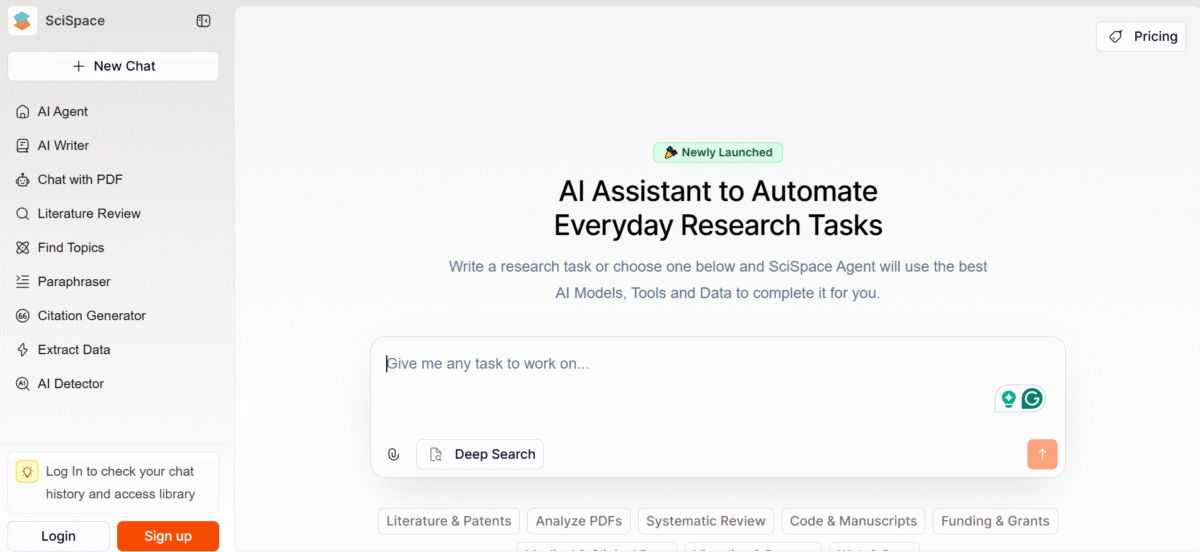SciSpace AI is a research tool that helps students, researchers, and any other research professional read, understand, and generate scientific content. The focus of the tool is on understanding scientific text, as certain concepts in science can be notoriously complex.
SciSpace provides simplified explanations, summarization, and interactive features to clarify ideas.
Main Features
1. AI Agent
SciSpace’s AI agent interacts with and interprets scientific literature by acting like a chatbot and a summarizer. But beyond that, it acts like an intelligent, contextually aware assistant that helps users read, understand, and query academic papers.
The AI has a high level of reason and can understand the technical language, structure, and logic in peer-reviewed articles, technical documents, and preprints. Enclosed within this agent is an interactive PDF reader that provides basic functionalities.
For instance, when a user highlights a sentence, the AI can explain its meaning, elaborate on its significance, or relate it to other parts of the paper. This functionality can help decode dense methodology or theory that often intimidates professionals who are not as skilled.
2. AI Writer
The AI writer was designed with a focus on the fundamentals of scientific writing. When prompted, it crafts well-structured, grammatically sound, and discipline-specific content, complete with citations in multiple formats. These include APA, MLA, IEEE, Chicago, etc.
The AI writer also encourages collaboration. Users can upload existing papers or notes and continue working with the AI writer to refine the content until it meets the standard. In this refinement process, the AI writer will paraphrase, reword, and make tone adjustments.
Then, it will simplify overly complex language to promote understanding without sacrificing scientific accuracy. Yet, SciSpace still maintains research integrity and originality.
3. Chat with PDF
This is one of SciSpace’s most advanced features. Just like the name suggests, it lets users interact with PDFs, especially research papers, by questioning. When a PDF is uploaded, SciSpace AI scans the document and identifies its structure, sections, tables, charts, diagrams, data tables, figures, and citations.
This scanning process enables the AI to build an internal understanding of the content itself. So, when asked a question like “What were the main findings?” or “What does Figure 2 show?”, the AI can come up with a logical, accurate answer.
4. Literature Review
Literature reviews are notoriously arduous. Due to their extensive, comprehensive nature, they take long hours of intense research, reading, and writing to complete. However, they are a necessary part of the research process. Researchers need to understand the existing knowledge before making additions.
To reduce the time and effort it takes to complete, SciSpace uses AI to find, organize, and synthesize relevant academic research. All the user has to do is enter a topic or question, and the AI will run through a vast database to locate relevant material.
Next, it will generate an accurate summary of each of those materials, highlighting key points, methodologies, and contributions. Finally, it organizes the results into categories and themes. This makes it easy for the user to structure later on.
In addition to this, it will point out gaps in the literature as possible points of new research.
5. Data Extractor
This feature helps users quickly and accurately pull structured data from scientific research papers. The data extraction process starts when a paper is uploaded to the tool. After which, the AI checks for both qualitative and quantitative information. Then, it makes them available upon request.
6. AI Detection
SciSpace puts robotic-sounding text in check with its AI detection feature. SciSpace’s detection doesn’t just flag AI content; it also gives insights. It highlights specific sentences that seem suspicious for the user to review and reword. This promotes learning, rather than penalization.
7. Find Topics
SciSpace’s ‘Find Topics’ feature is a smart discovery tool that helps users explore other possible areas of interest within a research domain. It uses AI to identify and organize trending and relevant topics in the discipline.
8. Directory
SciSpace has a library that’s essentially a curated database of academic journals, conferences, and publishers. Its basic function is to help researchers find the right outlet for their work. And instead of extensive searching, users can browse within the directory for journals that match their field. They can also view conferences that might be open to presenting their work.
Using SciSpace
The AI Agent
The sign-up process was smooth, requiring only an email. I proceeded to ask the agent a general research question.
It turned up a compilation of research articles within the domain with links to the original research.
Then, the I agents started to run the task. I created a draft summary of important information pulled from the articles. It also prompted me to give it instructions to shape the direction of the tasks as it ran.
The summary consisted of a TLDR section, introduction, evidence, and topic-sub headers, and ended with a list of references.
I noticed that the AI agent listed the steps followed in its research. It first searched through SciSpace’s directory, then moved on to Google Scholar and finally PubMed.
This hints at high logical reasoning and also access to live information from the internet. The benefit of this is that users can be assured with the most up-to-date facts.
Essentially, the AI agent functions like an assistant or chatbot.
The AI Writer
SciSpace’s writer came up with two options: you can either start writing yourself or use a template. I went with the second option.
There were options to choose from depending on the type of writing to be done. I decided to go with the ‘Research Proposal’ template. Right above the templates, I noted a feature at the top titled ‘Papers’ that can help with relevant research during the drafting process. This will prevent cycling between tools and webpages.
To use the selected template (research Proposal), SciSpace asked for the proposed research topic
Then it used the topic to generate the research proposal structure I could fill in:
Next, I used the AI writer to generate one of the sections of the research proposal. One interesting thing I liked was that I had the option to either accept or discard the generated text, or ask the AI to draft a new one.
Chat with PDF
To use this feature, SciSpace let me choose between uploading a PDF or trying a sample one. I chose the latter. The sample PDF turned out to be a research paper that applied the attention-neural network mechanism in human brains to AI models.
Hovering the cursor over parts of the text presented me with options to select it as a statement to be used in questioning.
I proceeded to ask it a question and it turned up a detailed answer:
The response was concise, providing details where necessary while keeping out the fluff. I noticed that SciSpace references the sections of the PDF it drew its answers. This serves to assure the user of the accuracy of the feature.
The Bottom Line
SciSpace is a comprehensive tool for everything research-related. It assists at each phase, from the research proposal to the literature review, and even in making the final draft of the paper. It is an excellent recommendation for every researcher, whether a student or a professional.



